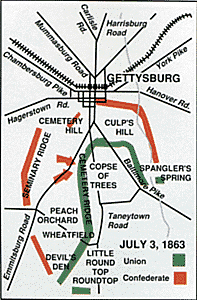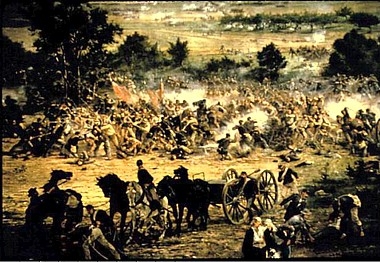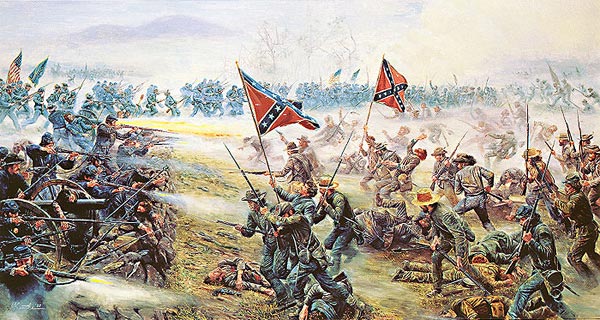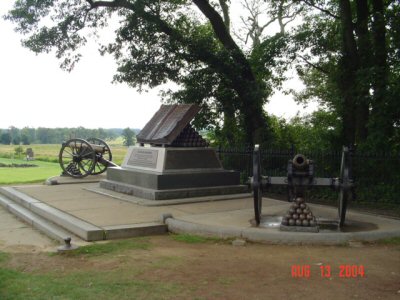This is the sixth in my series of week-long blog posts called Countdown to Gettysburg“. They are written from the perspective of someone who lived at that time and as if the internet existed in 1863.
The introduction to the series is here.
Previous Posts:
June 27, 1863
June 28, 1863
June 29, 1863
June 30, 1863
July 1, 1863
****************************************************
As I write this, there is a hint of red in the sky foreshadowing the dawn of another day in this war. That red means it will be another scorching day with temperatures in the 90’s. And for our boys camped out on the hills and ridges overlooking the town of Gettysburg, it means another day of desperate fighting.
Or maybe not.
I half hoped that Bobby Lee would try his old trick of giving us the slip and swing around our flank to make a dash for Baltimore or even Washington. That way, he could face us on ground of his own choosing by assuming a defensive posture, daring Meade to attack well fortified positions. I feel certain that he got that advice, probably from Longstreet. One look at the map below will tell you why:
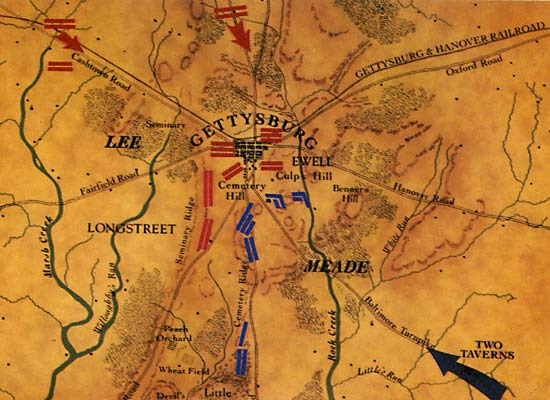
GETTYSBURG AT DAWN JULY 2
As you can see, our boys are in excellent position, better than we could possibly have dreamed. We occupy the high ground from Culps Hill in the north to the base of the hill called Little Round Top in the south. It kind of reminds me of a fish hook.
In short, a very strong defensive position on, as General Meade says, “good ground.”
During the night, General Sickle’s III Corps, along with General Hancock’s II Corps and General Slocum’s XII Corps arrived and were deployed expertly by Hancock. Reb strength is unknown but we should assume that most of their boys have arrived too. Right now, all we’re missing is VI Corps and they’re not expected to arrive until afternoon.
One note from yesterday’s battle; casualty figures are much worse than originally thought. In addition to losing General Reynolds, I Corps suffered an unbelievable 70% in casualties. They took upward of 10,000 men into battle and now have less than 2,500 effectives. That finishes I Corps as a fighting force, at least until it can be reorganized.
As for XI Corps, most of their losses are in the “missing, presumed captured” category. The fact that they broke and ran yesterday contributed in no small way to I Corps astronomical losses. They better fight well today. We’re going to need them.
It’s getting lighter in the east. Washington city is quiet, expectant, waiting anxiously for news. We hear that Grant sent a note to Pemberton asking him to surrender at Vicksburg. No reply yet but if true, the fall of that rebel stronghold on the Mississippi would be a devastating blow to the South.
But it won’t mean a thing unless our boys can whip Bobby Lee in Pennsylvania. And that’s something we’ve never done.
Check back for updates through the afternoon.
UPDATE
There’s an expectant quiet on the field. It’s almost noon, brutally hot and so far, the rebs have been satisfied with some exchanges of long range artillery fire and a few instances of pickets firing. Mr. Wilkerson of the New York Times has wired me with the information that General Sykes and his V Corps has arrived with General Sedgewick and the VI Corps expected shortly.
Lots of reb movement has been observed but so far, no attacks, not even cavalry skirmishes. I wonder what Bobby Lee is waiting for? Major Rathbone says to keep on eye on the left. He says army intelligence has put Pete Longstreet’s Corps opposite General Sickles who’s holding the extreme left next to a little stand of trees called Zieglers Grove. Rathbone thinks Lee will have his best Corps commander - Longstreet - lead the attack. It makes sense except for one thing; Bobby Lee never does the expected.
When I get any more reports, I’ll post again.
UPDATE II
It’s mid afternoon now and the news from Gettysburg is grim.
Mr. Wilkerson of the New York Times:
General Meade is beside himself because of the action taken by General Sickles. Posted on the extreme left of the Federal line, Sickles was dissatisfied with his deployment believing he could be flanked rather easily. About a half mile further left was a hill with a peach orchard on top. Sickles formed his line there thus leaving a gap in the Federal lines of about 1/2 mile and isolating him from the rest of the army. Here as a map of our positions at that time:

GETTYSBURG AT 3:00 PM JULY 2
Meade was fit to be tied when he saw this saying in response to Sickles promise to support Howard’s XI Corps that it would do no good, that the rest of the Army of the Potomac would have to instead support him.”
No sooner were the words out of Meade’s mouth than a tremendous cannonade was begun by the Rebels. Artillery Commander General Hunt, of whom I am a great admirer, ordered counter battery fire. His tactics are simple. Train 20 or 30 guns on one Rebel gun, dismount it, and move onto another. As you know, I believe that he and Colonel Haupt are the two most valuable officers in our army.
While this counterbattery fire was effective, the Rebels took a fearful toll of our boys, especially on Culps Hill on the right and the Peach Orchard where Sickles had ill advisedly placed his men. The rest of Sickles Corps was spread out in a line along the Emmittsburg Road. And that’s right where he was hit by Several divisions belonging to Reb General Mclaws.
Sickles men were being mowed down further to the left as well because General Hood’s Texans had attacked south of the little hill with the peach orchard and flanked that part of the line. There’s a spot directly below the hill known as Little Round Top that’s very rocky known as Devil’s Den. That place earned its name today as many a good man was lost on both sides during some desperate fighting. In the end, Sickle’s entire position was flanked and he was forced to retreat despite being supported by General Sykes V Corps.
As I’m writing this, Hood is making his way slowly up the Little Round Top. I sure hope we have some of our boys up there because if the Rebs take that hill, they can put a few guns up there and rake our entire line from left to right with shot and shell. We’d have to abandon the position entirely.
I’ll wire you later with details.
Wilkerson confirms much of what I’ve heard from the War Department today. I’ve also heard that the rebs are ready to move against Culps Hill on the right. Here’s what my source in the War Department thinks things look like at the moment on the extreme left of our position:

GETTYSBURG AROUND 6:00 PM JULY 2
I will have more as soon as I get it.
UPDATE III
As long as I live, I shall never forget what has just been relayed to me by an eyewitness in Colonel Vincent’s Brigade of General Barnes Division V Corps. It is, simply put, the most outstanding example of courage and intestinal fortitude I’ve ever heard.
It happened at Little Round Top. Following the rout of Sickles Corps by Hood’s men, several regiments of Alabama and Texas boys started to make their way up the undefended Little Round Top. Just in time, General Warren, who was operating a signals station on top of the hill, recognized the danger and sent out a call for the nearest available troops to come “at the double quick.”
Those troops belonged to General Barnes Division, a Pennsylvanian by the name of Colonel Strong Vincent. Vincent sized up the situation immediately. It was as dire as the Army of the Potomac ever faced.
If the rebs had been able to sweep Little Round Top, it would have been a relatively simple thing to drag a few batteries up there where, protected by a few regiments of infantry, they could have shelled the entire Union line all the way past Cemetery Ridge to Culp’s Hill. The army would have to leave. And with Lee putting pressure along the entire front, it’s likely such a movement would have turned into a rout.
High stakes indeed. Vincent placed his men along a spur of Little Round Top just below the summit. Here are the dispositions of our boys:

Little Round Top 6:00 PM July 2
At the extreme left of the line was Colonel Joshua Lawrence Chamberlain’s 20th Maine. They were the anchor of the line. If they gave way, the entire army was flanked. Clearly, Chamberlain’s men would have to stand firm.
And stand firm they did, I’m proud to say. The rebs made charge after charge, each time lengthening Chamberlain’s lines out to the left a little more. Those Alabama and Texas boys were relentless. My eyewitness lost count of the number of times the rebs charged up that hill. Finally, it was apparent that Chamberlain would have to do something because his boys were almost out of ammunition. More than half his men were killed or wounded. He couldn’t retreat and if he stayed where he was, he’d be overrun.
So he ordered his boys to fix bayonets and charge!
That’s right. One lone regiment charging two divisions of rebs.
Well don’t ask me how or why, but his boys made a spirited charge down that hill, broke the backs of the reb effort to take the hill, and saved the Union army.
Like I said, I’ll never forget it as long as I live.
It’s getting near dark, but fighting is still raging all along the line. I’m told there’s a fierce fight around Culp’s Hill where General Wadsworth’s boys were temporarily dislodged by 3 divisions of Ewell’s Corps. I say temporarily because Wadsworth ordered a counterattack and after some of the worst hand to hand fighting of the war, our boys regained the hill. But Ewell’s boys aren’t going away. They may try a night attack to throw our boys off that hill.
And the rebs also made an effort to take Cemetery Hill right in the middle of our line. They actually broke through for a few minutes. Then the 1st Minnesota pulled something similar to Chamberlain’s feat and charged the attacking rebs. I hear their losses were 90%.
Other casualty figures are unavailable right now but the general consensus at headquarters is pretty grim. Sickles Corps was badly mauled and some other units on our left were also decimated. I should have a better idea by morning of where we stand.
About today, I guess you can say we’re holding our own. That’s the best you can say. It was a very near thing in some cases, with the rebs extremely close to breaking through and splitting the army or flanking our boys and levering them off the ridge. And we paid dearly for it.
One sad note. Do you remember Mr. Wilkerson, the New York Times reporter whose son was a Colonel in the 127th New York? Well, the last my source saw of him was near the Devils Den where he was sitting, weeping uncontrollably next to the body of his dead son.
When this cruel war is over…

